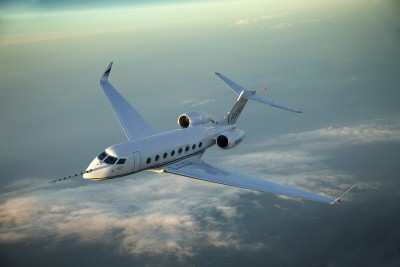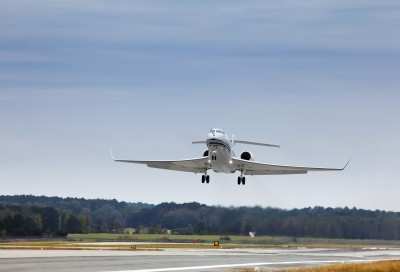Thu, Jan 13, 2011
Gulfstream Says First Flight Ever Using Electrically Powered
Flight-Control System
Gulfstream Aerospace Corp. test pilots and flight-test
engineers recently made business-aviation history when they flew
the Gulfstream G650 flight-test aircraft for the first time using
only an electrically powered, fly-by-wire backup flight-control
actuation system. Gulfstream's Serial Number (S/N) 6001 flew for a
total of 3 hours and 33 minutes on Dec. 21, 2010. Test pilots
Jake Howard and Gary Freeman along with flight-test engineers Bill
Osborne and Nathaniel Rutland evaluated the fly-by-wire system in
electric backup actuation mode for 2 hours and 20 minutes of the
flight, performing five landings with the backup system engaged.
"It flew so well that unless pilots were told they were in backup
actuation mode I don't think they would notice," said test pilot
Freeman.

File Photo
"The system performed flawlessly," said Pres Henne, senior vice
president, Programs, Engineering and Test, Gulfstream. "There was
no difference in handling qualities between the electrically and
hydraulically powered modes."
Typically, fly-by-wire uses a third hydraulic system to provide
redundancy in the event of a dual hydraulic system failure.
However, Gulfstream's fly-by-wire architecture uses electric backup
hydraulic actuators (EBHA): electrically controlled actuators that
are primarily hydraulically powered but offer electric power as a
backup. A self-contained hydraulic reservoir and motor pump allow
full operation should hydraulic loss occur.

The G650 has an EBHA at every primary control surface (elevator,
rudder and aileron) as well as the outboard spoiler. These provide
enhanced safety and aircraft availability because of the two
different power sources. The self-contained actuators also offer an
advantage following extremely rare failure scenarios, such as a
rotor burst.
The Dec. 21 G650 flight began with evaluating the electric
backup-mode handling qualities in one axis and then progressed to
full evaluations in all axes (pitch, roll and yaw). The test
conditions consisted of all flap settings at 10,000 feet for speeds
ranging from 1.13 reference stall speed (VSR) to maximum flap
extended speed (VFE). Cruise configurations were evaluated at
FL280, FL350 and FL450 and the full speed spectrum. The pilots also
initiated an emergency descent profile from FL450 to FL250.
Additionally, they evaluated handling qualities in the landing
configuration by making multiple offset approaches at Brunswick
Golden Isles Airport in Brunswick, Ga.
More News
Circle To Runway (Runway Number) Used by ATC to inform the pilot that he/she must circle to land because the runway in use is other than the runway aligned with the instrument appr>[...]
Aero Linx: National Aviation Safety Foundation (NASF) The National Aviation Safety Foundation is a support group whose objective is to enhance aviation safety through educational p>[...]
At Altitude Of About 250-300 Ft Agl, The Airplane Experienced A Total Loss Of Engine Power On November 6, 2024, at 1600 central standard time, a De Havilland DHC-1, N420TD, was inv>[...]
From 2009 (YouTube Edition): Three Hour Flight Was 'Flawless' -- At Least, Until Mother Nature Intervened For anyone who loves the aviation business, this was a VERY good day. Afte>[...]
Also: AMA Names Tyler Dobbs, More Falcon 9 Ops, Firefly Launch Unsuccessful, Autonomous F-16s The Air Force has begun ground testing a future uncrewed jet design in a milestone tow>[...]
 ANN's Daily Aero-Term (05.05.25): Circle To Runway (Runway Number)
ANN's Daily Aero-Term (05.05.25): Circle To Runway (Runway Number) ANN's Daily Aero-Linx (05.05.25)
ANN's Daily Aero-Linx (05.05.25) NTSB Prelim: De Havilland DHC-1
NTSB Prelim: De Havilland DHC-1 Classic Aero-TV: The Boeing Dreamliner -- Historic First Flight Coverage
Classic Aero-TV: The Boeing Dreamliner -- Historic First Flight Coverage Airborne-NextGen 05.06.25: AF Uncrewed Fighters, Drones v Planes, Joby Crew Test
Airborne-NextGen 05.06.25: AF Uncrewed Fighters, Drones v Planes, Joby Crew Test




